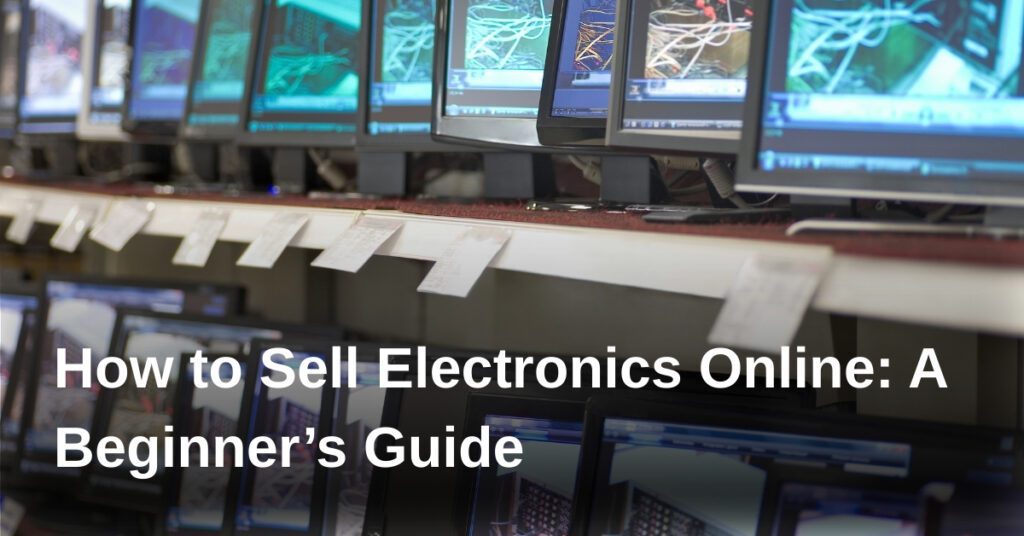
In an age where technology evolves at lightning speed, many individuals find themselves with a surplus of gadgets. The solution? Learn to sell electronics online. Whether you’re an enthusiastic techie looking to pass on your old favorites or simply someone who upgraded their devices, understanding this process can seem daunting. However, advancements in e-commerce platforms simplify this task, making it accessible for beginners. By recognizing the right platforms and employing effective strategies, you can not only create a better experience for buyers but also maximize your earnings. Therefore, if you’re ready to transform clutter into capital, this guide will illuminate every step.
Main Points
- Choose the Right Platform: From large-scale marketplaces like eBay to specialized tech sites, choosing the correct platform depends on your needs. Each has its advantages and fees, so research is crucial.
- Understand Your Product: Accurate knowledge about the specifics of your device, including model, specifications, and condition, is vital. It helps in setting the right price and improving buyers’ confidence.
- Craft a Compelling Listing: Detail your item with clear descriptions and crisp images. Competent listings stand out, increasing potential buyers’ interest.
- Price Strategically: Look at similar listings and consider fees and shipping costs when pricing your item. Competitive pricing can attract more buyers.
- Ensure Secure Transactions: Use trusted payment methods and ensure that you securely pack your electronics to protect them in transit. It’s essential for building credibility and ensuring a smooth sale process.
Understanding the Online Electronics Market: Key Trends and Opportunities
The online electronics market is evolving, driven by dynamic factors reshaping consumer preferences and business models. As consumers increasingly opt for convenience, the demand to sell electronics for a fair price via online platforms is escalating. This trend reflects a broader shift towards digital marketplaces which offer diverse opportunities only limited by imagination. Nevertheless, the market is complex. Consumers search for platforms to sell electronics near their location, valuing accessibility and speed. They favour platforms offering secure transactions and fair pricing, while retailers strive to adapt to their needs. Emerging trends in this domain present several opportunities:
- Artificial Intelligence: Personalized recommendations can enhance user experience.
- Eco-conscious Shopping: Consumers are choosing sustainable options.
- Second-hand Product Demand: Economic factors push buyers to explore used items.
Successfully navigating this landscape requires understanding consumer behaviour deeply, yet opportunities abound for those ready to embrace change.
Choosing the Right Platforms: Where to Sell Your Electronics Online
When considering where to sell electronics online, the choice of platform significantly impacts success. First, assess the value and condition of your items. For example, high-value devices may fare well on platforms like eBay or Amazon due to their extensive reach and reliability. However, if seeking a specialized audience, Swappa offers a space catered specifically to smartphones and tech gadgets, ensuring a tech-savvy buyer base. Meanwhile, Craigslist or Facebook Marketplace can provide local selling options. These may be beneficial when you prefer in-person transactions, avoiding shipping fees. Yet, they carry the uncertainty of finding genuine buyers. Alternatively, refurbished products can be pitched to sites like Gazelle or Decluttr, which simplify the selling process, yet may offer lower returns. Therefore, understanding your product and the platform’s dynamics is crucial. Each has its peculiarities, fit for diverse needs when it comes to selling electronics efficiently.
Crafting Compelling Product Descriptions: Engage and Convert Shoppers
Product descriptions are more than mere words on a page; they are the silent yet persuasive voice that can turn a curious browser into a committed buyer. Effective descriptions weave a narrative that combines details, benefits, and a touch of imagination. To engage and convert shoppers, descriptions must not only inform but also entice. For instance, describing a Sell electronics product as “sleek” gives a visual cue, whereas “user-friendly” highlights functionality. However, beyond adjectives, the key is clarity—how does this product improve the user’s life? Don’t just list features; translate them into benefits. Consider the customer standing in-store, hesitating. What’s the deciding factor? Perhaps it’s the assurance of improved productivity offered by your Sell electronics gadget, or the aesthetic appeal of its design. Therefore, crafting descriptions that sell requires an intuitive blend of detailed imagery and strategic eloquence—offering readers not just information, but also vision and desire.
Optimizing Product Listings for Search: Tips for Better Visibility
To enhance your product visibility online, optimizing your listings is crucial. Begin by using descriptive titles and keywords to make your products discoverable. An effective title should include primary keywords, succinctly describing the product. Additionally, leveraging bullet points to outline features and benefits can significantly improve readability and user experience.
Descriptions play a vital role in sell electronics since they guide potential buyers by highlighting product details. Therefore, it is essential to keep them detailed yet concise. Incorporate relevant search terms naturally to improve your rankings without forcing them into every sentence.
Images often speak louder than words. High-quality photos showing multiple angles can significantly enhance appeal. A savvy seller doesn’t overlook video content either, which can be especially persuasive. Additionally, maintaining competitive pricing and providing free shipping can further increase your product’s attractiveness.
Finally, never underestimate the power of customer reviews. Positive reviews can not only boost credibility but also enhance search engine rankings by providing fresh, user-generated content.
Pricing Strategies for Electronics: Maximizing Profit and Competitiveness
Setting the right price for electronics can be a conundrum, often balancing between maximizing profit and ensuring competitiveness. Companies primarily adopt strategies such as cost-plus pricing, value-based pricing, and dynamic pricing. Cost-plus involves adding a markup to the cost of manufacturing, thereby simplifying the decision-making process. Nevertheless, this may not always be ideal in fluctuating markets. Value-based pricing, on the other hand, takes customer perceptions into account—sometimes charging premium prices if consumers see the value. Though this can lead to higher returns, it demands deep market insights to execute effectively. Meanwhile, dynamic pricing adjusts based on real-time supply and demand conditions, which can be extremely beneficial in fast-moving industries. The implication here is significant: knowing when to sell electronics at a discount or premium can influence both market reach and profitability. Despite this, brands must carefully analyze their objectives and market conditions to adopt the most fitting strategy.
Leveraging High-Quality Images and Videos: Showcase Your Products Effectively
In today’s digital world, capturing and maintaining consumer interest relies significantly on high-quality images and videos. Stunning visuals not only enhance a product’s appeal but also instil a sense of trust in potential buyers. Therefore, it is crucial to understand how to showcase your products effectively using these tools. First and foremost, ensure the lighting and environment are optimised to reflect the true qualities of your products. Subtle details matter; hence, clear and detailed imaging can make your products more enticing.
Adding a story can further enrich engagement. A short video that illustrates the product in real-life situations offers a glimpse into its benefits. This approach can particularly bolster interest in niches that rely on tangible interactions. Despite this, balance is key. Overly elaborate visuals might distract rather than engage. As one empathetic marketer put it,
“Sometimes less is more, if the little you show speaks volumes.”
Moreover, when you Sell electronics effectively online, focus on showcasing functionalities as well as aesthetic attributes. Ultimately, the harmony between imagery and product utility ensures that these visual representations serve not just to attract but to inform, and ultimately convince, customers.
Building Trust with Buyers: Ensuring Secure Transactions and Reliability
Establishing trust with buyers is imperative for fostering long-term relationships and ensuring recurring business. When customers choose to sell electronics online, they often experience anxiety over the possibility of fraud. Therefore, prioritising secure transactions helps to ease these concerns substantially. Implementing a trusted payment gateway is a crucial first step, but assuring buyers of your reliability goes beyond just that.
Communication plays a pivotal role. Regular updates and transparent communication make buyers feel informed and valued. Additionally, offering a clear return policy can alleviate any lingering doubts. Some might argue over the necessity, yet a well-articulated policy actually boosts buyer confidence.
Steps to Build Trust
- Secure payment methods: Use reputable options to safeguard transactions.
- Feedback system: Encourage reviews for credibility.
- Clear return policy: Offer straightforward terms to instil confidence.
By focusing on these elements, you not only build trust but also create an environment where buyers feel comfortable making transactions. Consequently, this trust becomes the foundation for a successful and reliable business model.
Handling Shipping and Returns: Best Practices for Customer Satisfaction
In the complex world of shipping and returns, achieving customer satisfaction can sometimes be a delicate balance. Clear communication stands as a cornerstone—customers appreciate transparency about shipping times and return policies. However, simply outlining these details on your website isn’t always enough. A responsive customer service team, available to address concerns and possibly unexpected obstacles, reinforces trust.
Furthermore, offering free returns may enhance a customers’ experience; albeit, not every business finds this feasible. Instead, you could consider providing return labels or a straightforward return process, reducing hassle for the buyer. It’s crucial to have a reliable logistics partner—delays and inaccurate deliveries can tarnish your reputation.
Despite this, even the most robust system faces challenges. Do these practices ensure 100% satisfaction? Perhaps not entirely, but they certainly pave the way for fewer misunderstandings, better customer engagement, and, hopefully, increased loyalty. Your commitment to this balance can significantly impact how your business is perceived.
Utilizing Social Media and Digital Marketing: Drive Traffic and Increase Sales
Effective use of social media and digital marketing is crucial in today’s competitive landscape for driving traffic and boosting sales. These platforms offer unprecedented access to vast audiences, allowing businesses to reach potential customers more efficiently than traditional methods. Engaging content is key; therefore, developing creative campaigns can spark interactions that lead to increased brand awareness. However, merely having an online presence isn’t enough. Creating authentic and relatable posts helps in building a deeper connection with your audience, encouraging them to engage regularly with the content.
Specific Strategies
Leveraging analytics can provide insights into consumer behaviour, allowing businesses to adapt their strategies accordingly. Targeted advertising, when done correctly, can be exceptionally effective in converting viewers into buyers. For those aiming to sell electronics, there’s an opportunity here to display products through visual storytelling on various platforms, such as Instagram or Facebook, thereby enhancing visibility and interest. Nevertheless, it’s important to balance promotional efforts with meaningful interaction to maintain audience engagement and loyalty.
Conclusion
Selling electronics online might seem daunting at first, but with the right approach, it can be both rewarding and profitable. Remember to focus on creating detailed product listings and offering excellent customer service to set yourself apart from competitors. Building a trustworthy brand is key, so engage with your audience and cultivate genuine relationships. Utilize different selling platforms and continuously optimize your strategies based on feedback and market trends. Ultimately, patience and persistence will be your allies in mastering the art of online electronics sales.
Related Articles:
How to Sell Autographs Online: A Beginner’s Guide
